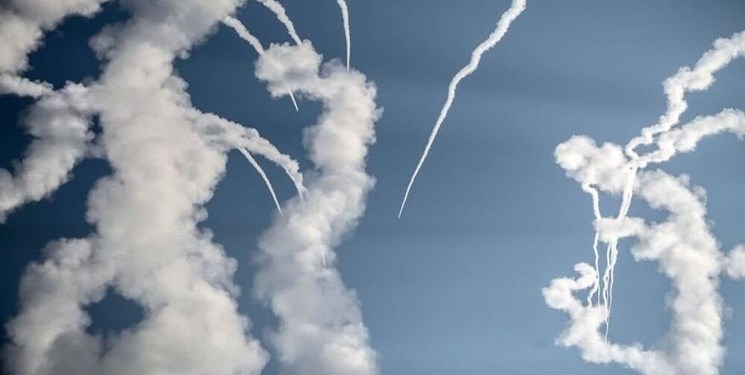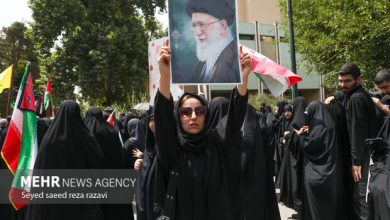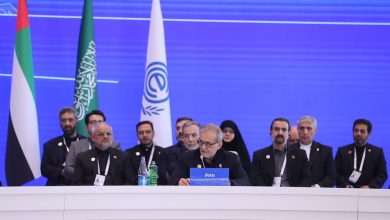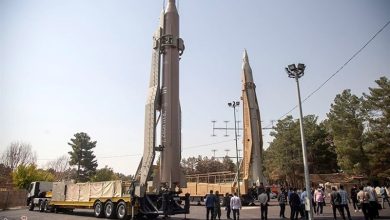IRGC Aerospace Commander: Missiles Aimed at Defusing Enemies’ Threats

Islamic Revolution Guards Corps (IRGC) Aerospace Commander Brigadier General Ami Ali Hajizadeh said the Great Prophet 15 drills have been aimed at thwarting enemies’ threats, describing Iran’s missile program as a vital component to boost the country’s defensive might.
“The missile program is a means of producing power and security for Iran,” Brigadier General Hajizadeh said on Saturday on the sidelines of the final stage of Payambar-e Azam 15 (Great Prophet 15) drills.
“In case the enemy dreams of making a wrong move against Iran’s security and integrity, the country’s Armed Forces are ready to respond firmly through the ground, air and sea,” he stressed.
He went on to say that the current wargames and the other large-scale exercises that have been held over the past 15 days and will continue for the next five days indicate the Iranian Armed Force’s preparedness in all arenas.
Noting that the range of Iran’s missiles used to be 300 km in the Persian Gulf, he said, “Today, our goal was to destroy the enemy fleet in the Northern Indian Ocean, 1,800 km away.”

IRGC Aerospace Commander Brigadier General Ami Ali Hajizadeh
Earlier today, the IRGC destroyed hypothetical enemy warships at a distance of 1,800 kilometers with ballistic missiles in the final stage of Payambar-e Azam 15 (Great Prophet 15) wargames.
The IRGC carried out the final stage of the Great Prophet 15 drills on Saturday with strategic operations of long-range ballistic missiles that successfully hit the hypothetical enemy’s vessels 1,800 kilometers away in the North of the Indian Ocean.
This stage was held in the presence of Chief of Staff of Iranian Armed Forces Major General Mohammad Hossein Baqeri, IRGC Commander Major General Hossein Salami, IRGC Aerospace Commander Brigadier General Amir Ali Hajizadeh and a number of top brass of Iran’s Armed Forces.
After detection of the hypothetical enemy ships’ position by the IRGC Aerospace reconnaissance systems, long-range ballistic missiles of various classes were fired from the Central deserts of Iran and successfully hit and destroyed all targets in the Northern Indian Ocean some 1,800 kilometers away.
Senior Political Analyst Seyed Mostafa Khoshcheshm says this specific operation had been planned to carry a special message to Iran’s foes.
“Certainly, the precision-striking capability and destruction power of these long-range ballistic missiles produce an image in action, which comes to play a pivotal role in the military assessments of Iran’s enemies, specially when one considers the timing of this very meaningful part of the drills,” he said.
In relevant remarks on Friday, General Hajizadeh said his force has created a new power for Iran in Great Prophet 15 drills through a combination of a variety of capabilities with artificial intelligence.
“Through the combination of new missile capabilities and drone operation with artificial intelligence, today a new power was born in the IRGC,” Hajizadeh said on the sidelines of Payambar-e Azam 15 (Great Prophet 15) wargames on Friday.
“The first stage of the drill was a simulator for attacking the enemy’s power points and defensive lines,” he said, adding that this stage was carried out using a combination of drones and missiles.
“First, drone units targeted the defensive systems of the hypothetical enemy, and then, ballistic missiles destroyed the main assets and sections of the enemy base,” the Brigadier General went on to say.
“Missiles used in this stage of the wargames are a new generation of ballistic missiles equipped with detachable warheads and low RCS (Radar cross-section),” Hajizadeh said, adding that the time for preparation and operationalization of these missiles has been decreased by 90%.
“These missiles are operational and can be launched in less than five minutes after deployment,” he stressed.
Attacking the hypothetical enemy from all sides and altitudes, hampering the enemy’s defensive ability, infiltrating enemy’s missile shield by detachable warheads, and using equipment designed and produced by domestic experts are among features of this drill, the commander said.
Islamic Revolution Guards Corps started the first phase of the Great Prophet 15 wargames with the IRGC Aerospace Force’s massive missile launch and drone operations in the Central Desert of Iran on Friday.
The first stage of the Great Prophet (Payambar-e Azam) 15 drills of the IRGC kicked off on Friday morning with the codename of “Ya Fatimah al-Zahar”, during which ground-to-ground ballistic missiles were fired and offensive drone bombers operations were put into action in the general area of Iran’s Central Desert.
During the drills that began in the presence of IRGC Commander Major General Hossein Salami, IRGC Aerospace Commander Amir Ali Hajizadeh and a number of senior commanders and officials of the Iranian Armed Forces, a new generation of ground-to-ground ballistic missiles and drones were used in compound offensive against hypothetical enemy bases, destroying all the specified targets.
During this stage of the wargames, after the attack of the IRGC Aerospace’s offensive bomber drones from all sides to the missile shield of the hypothetical enemy and complete destruction of targets, the new generation of the IRGC ballistic missiles of the classes of Zolfaqar, Zelzal and Dezful were mass fired at targets dealing fatal blows to the hypothetical enemy bases.
The missiles were Multiple Re-entry Vehicles (MRVs) with the capability of jamming and going through the enemy missile shield.
Great Prophet (Payambar-e Azam) wargames are annual missile tests and exercises conducted by Iran’s IRGC. The first series of the wargames began in July 2008.
In recent years, Iran has made great achievements in its defense sector and attained self-sufficiency in producing essential military equipment and systems.
The Iranian Armed Forces several times a year test their preparedness and capabilities as well as newly-manufactured weapons systems in different wargames.
The Iranian Armed Forces recently test-fire different types of newly-developed missiles and torpedoes and tested a large number of home-made weapons, tools and equipment, including submarines, military ships, artillery, choppers, aircrafts, UAVs and air defense and electronic systems, during massive military drills.
Iranian officials have always stressed that the country’s military and arms programs serve defensive purposes.
Defense analysts and military observers say that Iran’s wargames and its advancements in weapons production have proved as a deterrent factor.







